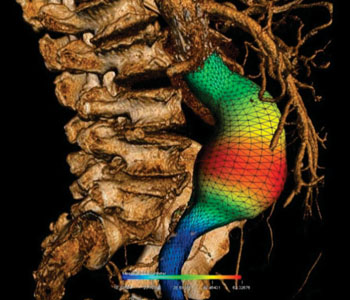Treating Aortic Aneurysms Through Virtual Reality
By MedImaging International staff writers
Posted on 19 Oct 2015
A new approach addresses problematic visualization of an abdominal aortic aneurysm (AAA) during surgery by creating a virtual model in the angiography room.Posted on 19 Oct 2015
Developed by researchers at the University of Montreal (Canada), the system is designed to facilitate endovascular aneurysm repair (EVAR) management by integrating anatomical imaging, biomechanical modeling, and biomarkers of AAA evolution to predict aneurysm growth or rupture, optimize stent planning and intraoperative guidance, and personalize EVAR follow-up. The system first evaluates ultrasound (US) screening results, followed by CT Angiography (CTA) to accurately evaluate orthogonal diameter and anatomical eligibility for EVAR.

Image: 3-D reconstruction of an AAA with color representation (Photo courtesy of Claude Kauffmann/University of Montreal).
This is accomplished by segmentation of the different components of the AAA—lumen, thrombus and calcification—which are then used to generate a numerical geometric model (called mesh) that serves as a basis for providing advanced geometric parameters of growth that can be associated with rupture. The model allows finite element analysis, including biomechanical properties such as peak wall stress (PWS) and peak wall relative index (PWRI), which relates to the mechanical stress and strength of the aneurysm wall.
Other data incorporated into the model include risk factors associated with aneurysm wall weakness, such as female gender, intraluminal thrombus thickness (ILT), and aortic diameter, which can be converted to the equivalent AAA diameter. Finally, software solutions are used to create a virtual model for stent-graft (SG) planning, using curved multiplanar CTA reformations alongside AAA and iliac artery centerlines. The study describing the procedure was presented at the Cardiovascular and Interventional Radiology Society of Europe (CIRSE) conference, held during September 2015 in Lisbon (Portugal).
“We superimpose the images, and this helps to visualize the area to be treated. But in reality, the tools we introduce into the body during the procedure deform the organs. We are testing right now a new approach that uses a computer to automatically recognize the tools introduced into the body and correct the deformities they cause,” said lead author Gilles Soulez, MD. “We hope this simulation-operation model will improve the accuracy of the procedure.”
AAA is the localized dilatation of the abdominal aorta exceeding the normal diameter by more than 50%, and is the most common form of aortic aneurysm; approximately 90% occur below the kidneys. The aneurysms can extend to include one or both of the pelvic iliac arteries. The major complication of AAA is rupture, which is life-threatening, as large amounts of blood spill into the abdominal cavity, and can lead to death within minutes. Mortality of rupture repair in the hospital is 60%-90%.
Related Links:
University of Montreal














